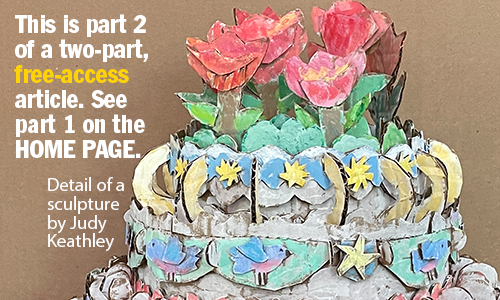
IT’S HARD, DURABLE, AND CRINKLY. WHEN IT GETS WET, IT CAN BECOME A BIG, HOT MESS. BUT THESE ARTISTS LOVE IT AND KNOW HOW TO EXPLOIT ITS EXPRESSIVE POWER.
by Edward M. Gómez
Some artists, like the London-based American Gina DeCagna (Instagram: @gdecagnaart; see our separate article about her on the HOME PAGE), use cardboard, unadulterated, as a raw material for creating large-scale, richly textured sculptural works, while others use cardboard more conventionally — but still very purposefully — as, for example, a support surface for paintings or drawings.
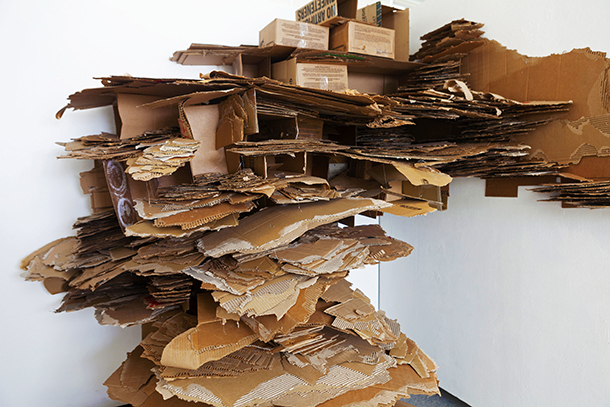
DeCagna’s handling of the corrugated-cardboard boxes she rescues from trash piles on the sidewalks and along the streets of London is as craftsmanship-oriented as, say, a ceramic artist’s hands-on shaping of a ball of clay. DeCagna tears into her material, ripping off the outer layer of a piece of cardboard to reveal the ridges of its inner layer of corrugated paper. Her resulting assemblage works are packed with actual physical texture as well as so-called visual texture.

The painter and writer Reda Rackley, who goes by the artist’s name “Bonewoman” (Instagram: @outsiderartbonewoman), is a self-described outsider artist who lives in Carmel Valley, near Monterey, in east-central California. Her paintings are notable for their images of crones, witches, and female-centered spiritual communities. (See Gray Campbell’s interview with this artist in brutjournal’s August 2022 issue.)
About making art, Bonewoman has said, “In painting, there’s magic in the process but there’s also history. Archetypal energy. Depth psychology. Mythology. Spirituality. Religion. There are so many dimensions. I don’t think that one would just want to reduce it to one dimension.”
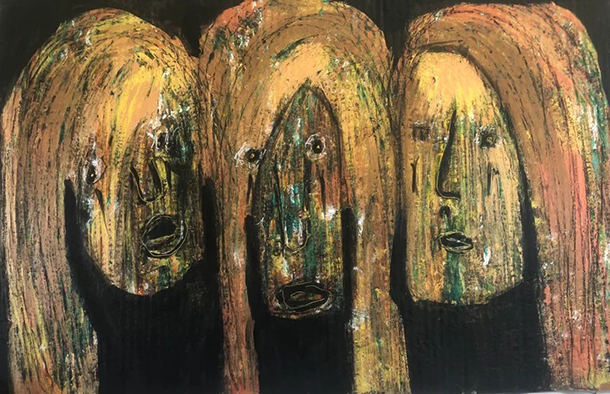
Recently, the artist sent us photos of several of her paintings for which she used found, corrugated cardboard as her pictures’ support surface. Sometimes, the ridges from the inner, corrugated-paper layer of a piece of paper, whose contours can be seen on the outer-layer surface of a sheet of cardboard, are also visible in Bonewoman’s painted images and become integral elements of her compositions.
Such visible, parallel-line traces of a cardboard sheet’s inner layer also pop up sometimes in the work of the artist Jim McManus, who makes paintings on various kinds of support surfaces as well as collages.
McManus, who is based in the riverside town of Hancock, in upstate New York, told us, “I use cast-off boxes. I’ve used Amazon.com boxes, large appliance boxes, and shoe boxes. It can be interesting to let the cardboard’s original stamping — whatever’s printed on it — show through as a compositional element, and I love the under-paint effect that cardboard gives. I like to use quick brush strokes and let the material show between the strokes. When using cardboard on the surface [of a painting], it’s easy to cut and tear. It’s a very versatile compositional element.”
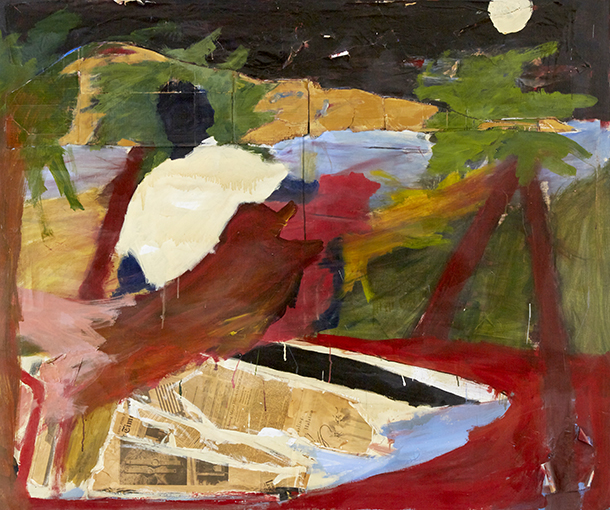
In such works as McManus’s “Night Drive” (acrylic, cardboard, newsprint and pencil on canvas), paint slathered over pieces of cardboard affixed to the picture’s surface contribute to and call attention to its crusty physical texture. McManus observed, “Because cardboard is so lightweight, it can easily be applied to any surface and worked with common tools, as opposed to wooden boards, metal, or plywood.” Recognizing cardboard’s versatility and ubiquitousness, McManus pointed out that he values being able to re-use a material that would otherwise be thrown away and appreciates that it’s an art supply that may be obtained free of charge. “We’re all familiar with the high costs of art materials,” he said.
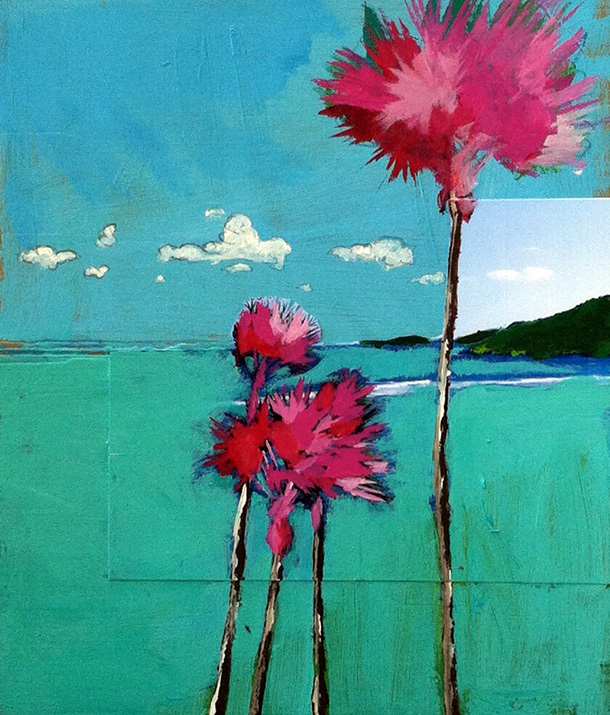
Recently, at the restaurant Uncle Brother in Hancock, New York, Jim McManus’s town, brutjournal’s visual director, Bill Westmoreland, came upon an exhibition of works by the contemporary Swiss artist Thomas Hirschhorn. Uncle Brother is owned and operated by the New York-based art dealer Gavin Brown; the restaurant, which is open during the summer and attracts artists and creative types from the upstate-New York region, houses a gallery space.
Always armed with a camera, Bill snapped a batch of photos of Hirschhorn’s curious concoctions — a few cars partially covered with taped-together sheets and pieces of corrugated cardboard. Hirschhorn, who attended art school in Zürich and was influenced by the work and ideas of Joseph Beuys and Andy Warhol, has issued a statement on his personal website about the works on view in the exhibition Custom Cars Culture at Uncle Brother; he refers to them as “Prototypes.”
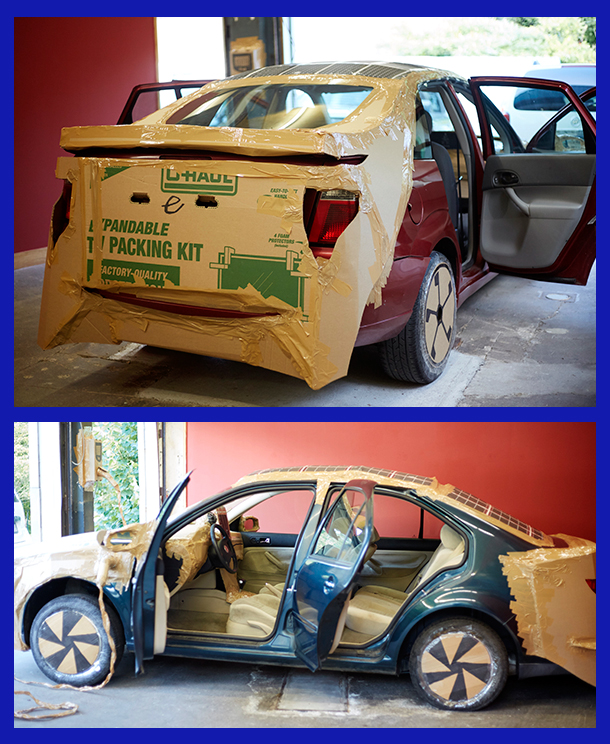
Describing these cardboard-covered cars, he writes, somewhat quizzically, that they seek to “give form to the desire to be ‘up-to-date’ or ‘turned-on,’ yet without being able to afford it: ‘I want an e-car too, but don’t have the money, therefore I transform my old car to make it look like one.’ The two cars presented here express that desire and lack of resources to make it become reality.”
Hirschhorn continues, “The only way to give a form to this desire is by simulating, by faking, and by thinking about this desire. What interests me is to understand this desire and lack of resources the other way around: logically, a prototype shows the future, points to the coming and would draw a utopia. Here, the nature of such a construction is deviated, the work ‘Prototypes’ designates a fallen utopia, a deception, a dystopia.”
In these works, Hirschhorn appears to have used corrugated cardboard to dress up conventional automobiles in the guise of would-be electronic cars.
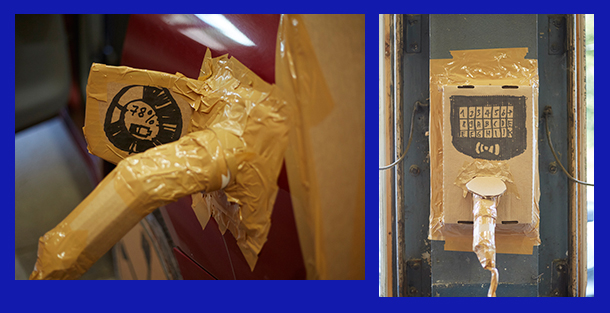
The artist Judy Keathley, who lives in Gainesville, Florida, makes sculptural objects that vividly capture corrugated cardboard’s unexpected potential for expressing mirth. Keathley told us, “I grew up in a small Arkansas town that offered no art classes at all from the first through the 12th grade. I didn’t go to art school but I don’t identify as an outsider artist, for I have been ‘taught’ by so many artists — trained and untrained. I live with my partner and two weird cats. I mostly work in cardboard and sometimes papier mâché. I’m currently working on my second quilt.”
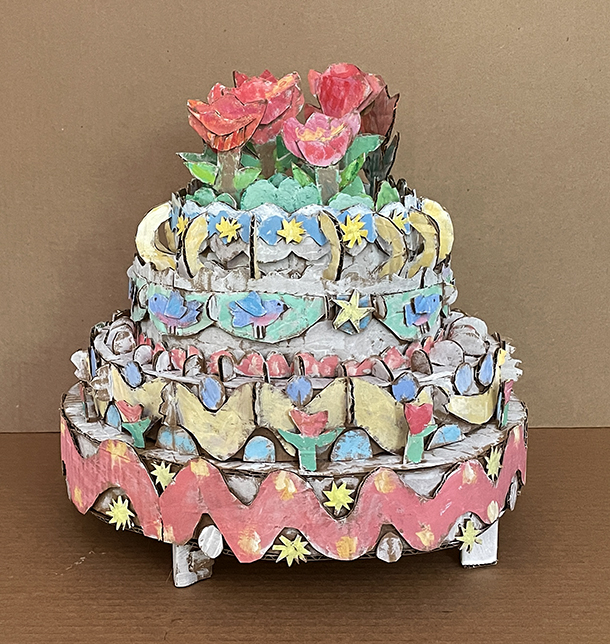
Remarkably, Keathley manages to squeeze a lot of texture and visual energy out of little more than her found cardboard and gouache, her preferred paint. She noted, “Most of my pieces have either two distinct sides or they are seen best viewed in the round. I’m not great at talking about what I do. I have an idea that becomes a jumping-off point, and then the rest tends to follow. I love old things. I mainly love art by true outsiders — and children. The work of Henri Matisse and Sophie Taeuber-Arp thrill me, too.”

One of the most remarkable bodies of art made with cardboard that we’ve discovered has been produced by an artist who creates, from scratch, his own corrugated cardboard.
Raphael Griswold, who earned degrees from Wesleyan University and Brooklyn College, and also studied in Spain, is based in Brooklyn. From his studio, he sent us a message saying, “My art is rooted in traditional printmaking and investigates how places express military-industrial power through their forms and their histories. Though I engage in an obsessive interrogation of a specific subject through prints, drawings and sculpture, my need to make things is fueled by the joy of negotiating processes rather than a desire to disseminate information.”
Like some of the other artists we’ve introduced here, Griswold explained that he is interested in the ways in which “global commerce and the shipping industries have become quotidian aspects of our lives as we do more shopping online and receive more and more stuff in boxes.” He said, “I’ve been reflecting on cardboard as a ubiquitous material by making corrugated cardboard by hand. I like the absurdity of making cardboard by hand but I’ve also begun to appreciate the fact that industrially produced corrugated cardboard [offers] a near-perfect design solution for all sorts of applications.”
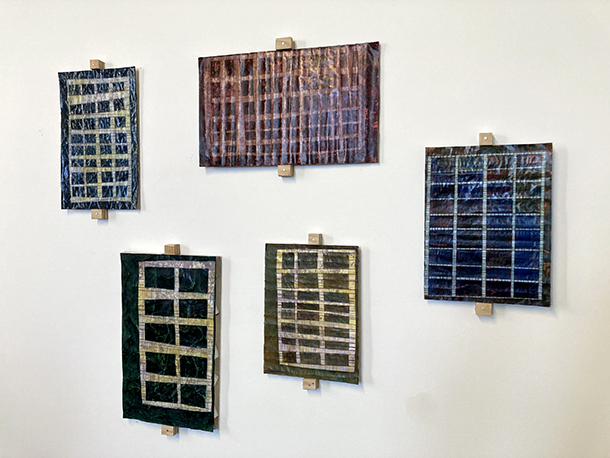
As a cardboard connoisseur, Griswold noted, “I’ve always been fascinated by mass-produced boxes, the printing on them, its perfection, and the possibility that these objects are ready-made substrates for drawing, painting, and other visual artworks. I’m trying to produce semi-durable ‘paintings’ by transforming works on paper into cardboard. I still don’t know where this work is going but I’m excited by the experiments it has yielded so far.”
We were intrigued by Griswold’s laborious method of producing his own corrugated cardboard. Describing his process, he said, “I make my own cardboard sheets, beginning by printing imagery on both sides of the paper that is assembled into the corrugated panels. The printing medium is commercial sheet-fed offset lithography. This process is rather time consuming, as follows: I hand-draw a grid on lithographic printing plates, then print these images onto both sides of a stack of paper using an old Multilith 1250 sheet-fed, commercial-offset, lithographic printing press.”
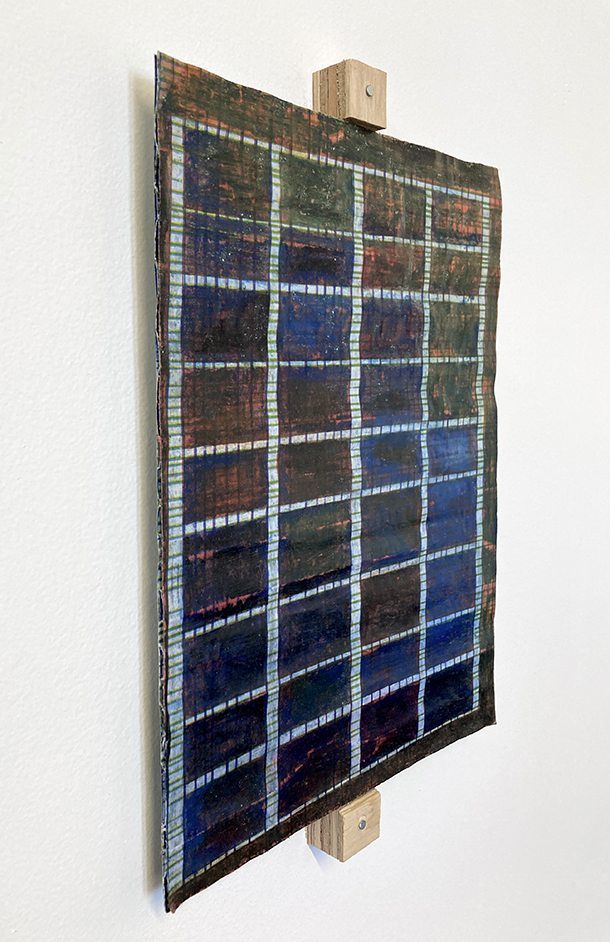
“I take the prints and dampen them, then use a DIY ‘crimping’ set-up to fold them into fluted sheets that can be used as the corrugated layer of my cardboard. Once the corrugated layer is dry, I glue several pieces of the corrugated paper together to form a single, larger sheet for the middle layer of the cardboard. I glue top and bottom sheets of my hand-drawn graph paper to the corrugated layer to produce a homemade approximation of a typical, three-ply carton sheet of cardboard. The cardboard is left to dry under weight for 24 hours.”
There is more to Griswold’s process. He added, “Once glued, I draw grids on the graph-paper surface of the cardboard. When I’m satisfied, I apply furniture finishing paste wax to both sides of the cardboard drawing and buff it to a lustrous finish. Alternatively, if the cardboard feels flimsy, I experiment by adding a second layer of fluting and another face sheet to cardboard panels in order to increase rigidity. The result is a five-ply sheet of cardboard.”
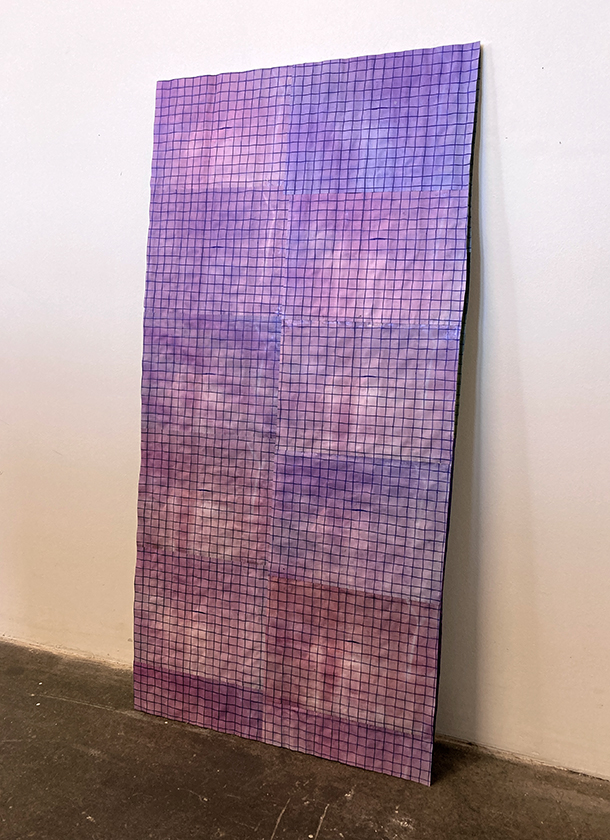
Many viewers may never be aware of the painstaking effort Griswold outs into producing his art-making material. The results of his use of his homemade cardboard include some classically geometric-abstract compositions that, for all their cool minimalism, exude the warmth of the touch of a true craftsman’s hand.
Griswold told us he is interested in how an artist’s materials can “dictate form” and in how a particular material’s history itself may “contribute to the ‘voice’ of the artwork.”
As fellow cardboard aficionados, we understand exactly what he means.


